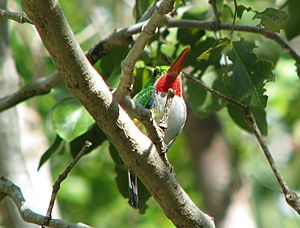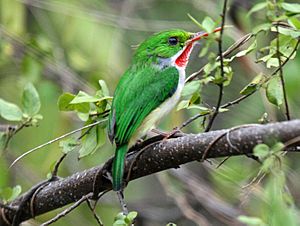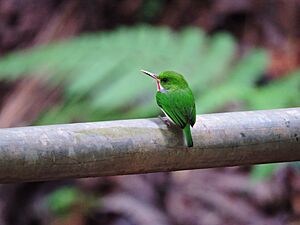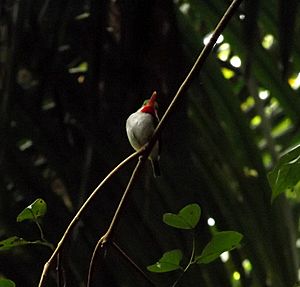Puerto Rican tody facts for kids
Quick facts for kids Puerto Rican tody |
|
|---|---|
 |
|
| Conservation status | |
| Scientific classification | |
| Genus: |
Todus
|
| Species: |
mexicanus
|
The Puerto Rican tody (Todus mexicanus) is a small, colorful bird. It lives only on the island of Puerto Rico. Local people often call it "San Pedrito", which means "Little Saint Peter".
This bird is one of five unique Todus species found in the Greater Antilles. Each island, like Cuba, Jamaica, and Puerto Rico, has its own type. The Puerto Rican tody is special because it's the only one without pink or yellow-green feathers on its sides.
Contents
About the Puerto Rican Tody
The Puerto Rican tody is related to motmots from Central America. Scientists think the Jamaican tody might be its ancestor. This could have happened after hurricanes spread birds to new islands. The Todus group likely developed a very long time ago.
What Does the Puerto Rican Tody Look Like?
The Puerto Rican tody is a tiny, bright green forest bird. It is one of the smallest birds in its group. It is about 11 cm (4.3 inches) long and weighs only 5 to 6 grams. That's about the weight of a few paper clips!
Its back is emerald green. Its sides and under its tail are light yellow. Its belly and chest are white. This bird, also called "Medio Peso" by locals, has a red throat and a long, wide red lower beak. Its legs and feet are brownish.
Male and female todies look very similar. The only way to tell them apart is their eye color. Males have gray eyes, while females have white eyes. Young todies look like adults but don't have the red markings. Their bellies are grayish, and their beaks are shorter.
Where Do Puerto Rican Todies Live?
You can find the Puerto Rican tody all over the main island of Puerto Rico. They mostly live in forests. They especially like damp forests at high altitudes. These places have lots of insects for them to eat. They also live in thick, dense bushes, like in the Guánica State Forest.
Tody Territories
Todies have small areas they call home. In lowland forests, a pair might have a territory of about 0.7 hectares (1.8 acres). But in higher places, where there are fewer insects, their territory can be bigger, up to two hectares. They defend their home area all year long.
How Todies Defend Their Space
When another bird comes too close, the Puerto Rican tody fluffs up its feathers. It might also bob its head up and down and make sounds. Males tend to bob more than females. This bobbing can also happen after they eat or while building a nest.
They might also chase intruders or flick their wings. Most of these actions are for other todies. They usually don't mind other types of birds in their area.
What Do Puerto Rican Todies Eat?
The Puerto Rican tody mainly eats insects. About 86% of its diet is insects. They eat things like grasshoppers, crickets, dragonflies, flies, and beetles. They also eat spiders. Sometimes, they might eat small lizards or frogs. Todies are known for eating a lot!
Todies hunt in different ways. The most common way is "leaf feeding." They sit quietly on high branches and look for insects on leaves below. When they spot an insect, they quickly fly to catch it and then return to a branch.
They also "air-feed." For this, they point their beaks up. They fly from a branch, snatch an insect in the air, and then land on a different branch. They mostly find food on leaves, but rarely on the ground. They catch about one to two insects per minute.
Baby todies eat a bit differently. Adults feed them mostly insects like leafhoppers and moths. But they also give them fruits from a plant called Clusia krugiana. They also feed their babies frogs and lizards, with frogs being more common.
Reproduction and Life Cycle
Puerto Rican todies usually have one family of babies each year. They stay with the same partner. Their courtship, or dating period, is strongest from February to May. It happens near where they will build their nest.
During courtship, they chase each other and make rattling sounds with their wings. Both males and females fluff out their side feathers before mating. Their calls become faster and more excited.
Nesting and Raising Young
The Puerto Rican tody has a unique way of nesting. Over about eight weeks, the male and female dig a narrow burrow in an earth bank. This burrow is usually 25 to 35 cm (10 to 14 inches) long and has a right-angle turn. They build their nest at the end of this tunnel. This digging happens between February and June, before the rainy season starts.
Females lay their eggs 3 to 4 weeks after the nest is ready. They lay 1 to 4 bright white eggs, usually one egg each night. The average is about 2 or 3 eggs. Each egg weighs about a quarter of the female's body weight. Both parents take turns sitting on the eggs for about 21 days. Sometimes, older offspring from previous years help care for the chicks after they hatch. If a chick dies, or during incubation, the mate will bring food to the nest.
Todies often dig new burrows every year. About 89% of these new nests are within 10 meters (33 feet) of their old ones.
Tody Behavior
Puerto Rican todies are rarely seen on the ground. They prefer to perch on branches. When they are on the ground, they hop. It's interesting that they have a favorite spot to land before entering their burrow. Unlike some other birds in their group, Puerto Rican todies sleep alone in trees both day and night.
How Todies Control Their Body Temperature
Scientists have studied the Puerto Rican tody a lot because of its unusual body temperature. Most birds in its group have a body temperature of 40 °C (104 °F). But Puerto Rican todies can keep their body temperature at 36.7 °C (98.1 °F). This means they use 33% less energy than other similar birds. They can even lower their body temperature by 14 °C (25 °F) if needed.
This ability changes with the seasons and between males and females. Only females during breeding season can enter a state called "torpor." In torpor, they are still, their eyes are closed, and their feathers are fluffed up. But they can fly away quickly once their temperature rises.
Status and Conservation Efforts
The Puerto Rican tody is a common bird unique to Puerto Rico. It is currently listed as a Least Concern species by the IUCN. This means it is not currently at high risk of disappearing.
In the past, people used to catch Puerto Rican todies for food. Today, their nests are sometimes attacked by Indian mongooses, which were brought to the island. Other threats include losing their forest homes. Also, some coffee farms are changing from shaded areas to sunny ones, which is not good for the todies.
See also
 In Spanish: San pedrito de Puerto Rico para niños
In Spanish: San pedrito de Puerto Rico para niños





